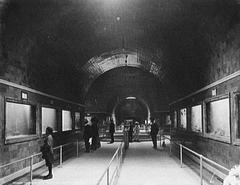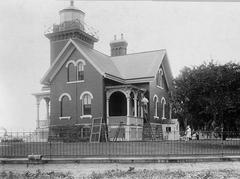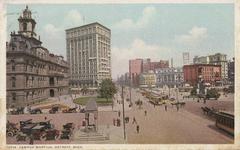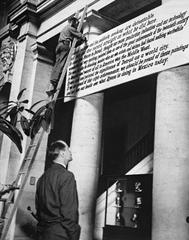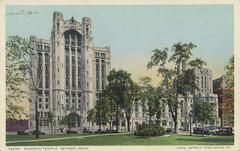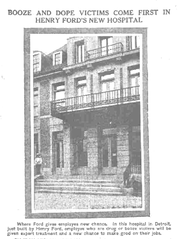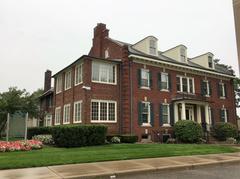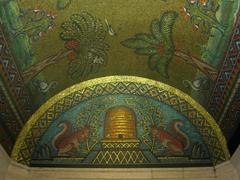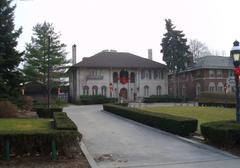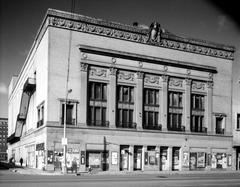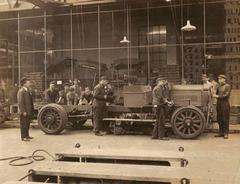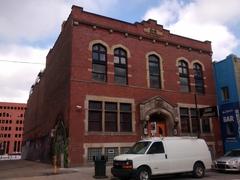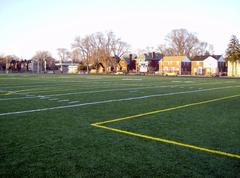
George W. Loomer House Detroit: Visiting Hours, Tickets, and Historical Site Guide
Date: 04/07/2025
Introduction
The George W. Loomer House stands as a striking emblem of Detroit’s Gilded Age, nestled in the heart of Midtown’s Warren–Prentis Historic District. Built in 1887, this Richardsonian Romanesque masterpiece reflects not only Detroit’s architectural grandeur but also the city’s evolution through periods of prosperity, decline, and revitalization. Designed by Almon C. Varney for prominent lumber dealer George W. Loomer, the house’s robust stonework, turret, and intricate masonry make it a must-see for architecture enthusiasts and urban explorers (Detroit1701.org; Wikipedia).
Though the Loomer House is primarily a private residence today, it continues to anchor a historic block and serves as a focal point for walking tours and special events. This comprehensive guide details its history, architectural significance, visiting logistics, and tips for exploring the surrounding cultural corridor.
Historical Background and Architectural Significance
Origins and Construction
Commissioned in 1887 by George W. Loomer, the house was designed by architect Almon C. Varney in the style popularized by H.H. Richardson. Its $4,300 construction cost reflected both Loomer’s wealth and the prestige of what was then one of Detroit’s most fashionable neighborhoods (Detroit1701.org). The house’s stout stone base, arched windows, and distinctive turret exemplify Richardsonian Romanesque architecture, while its oak interiors and grand staircase hint at the opulence of its original era (Wikipedia).
Early Ownership and Neighborhood Context
After Loomer sold the property in 1891, it passed to Mulford T. Hunter, a retired steamboat captain, who later built the adjacent Hunter House. These two residences are the only 19th-century structures remaining on their block, now part of the Warren–Prentis Historic District (Detroit Historical Society).
Changing Uses and Preservation
The house remained in the Hunter family until 1951, when it was converted into apartments to meet changing housing demands. Despite interior modifications, the exterior has remained remarkably intact. In 1994, the Loomer House was added to the National Register of Historic Places, recognizing its importance to Detroit’s architectural and social history (Wikipedia).
The Warren–Prentis Historic District: Context and Character
The Warren–Prentis Historic District is renowned for its blend of Queen Anne, Romanesque Revival, and Colonial Revival architectural styles. The Loomer House is one of 108 historic buildings in this nationally recognized enclave, which flourished during Detroit’s late 19th- and early 20th-century expansion (Detroit Historical Society).
The district’s early development was fueled by streetcar access and proximity to Detroit’s burgeoning industrial core. Despite periods of decline, the neighborhood has experienced significant revitalization, thanks in large part to the stabilizing presence of Wayne State University and the Detroit Medical Center. Today, the area is a vibrant blend of students, professionals, and longtime residents.
Visiting the George W. Loomer House
Visiting Hours and Admission
- Regular Access: The George W. Loomer House is a private residence and not open for regular interior tours.
- Exterior Viewing: Visitors may view and photograph the house’s exterior from public sidewalks at any time.
- Special Events: Occasional public access is available during events like Doors Open Detroit or guided walking tours. These are typically announced by local heritage groups such as Preservation Detroit or the Detroit Historical Society.
Tickets
- Exterior Viewing: Free; no tickets required for viewing or photographing from the street.
- Special Events: Tickets for tours or open houses, when available, are typically $10–$20 and can be purchased through event organizers’ websites.
Accessibility
- Exterior: Sidewalks are generally accessible, but may be uneven in places. The house itself is not wheelchair accessible due to steps and its historic design.
- Nearby Attractions: Local museums and cultural sites offer full accessibility (Visit Detroit).
Travel Tips and Nearby Attractions
- Location: 71 W. Hancock St., Detroit, MI – centrally located in Midtown, near Wayne State University and major museums.
- Transit: Served by the QLINE streetcar, DDOT buses, and bike-share stations (MoGo Detroit). Metered street parking is available but limited during peak hours.
- Best Time to Visit: Spring and autumn offer the most pleasant weather. Early mornings and late afternoons provide ideal light for photography.
- Safety: Midtown is generally safe, especially near cultural institutions, but standard urban precautions are advised (Lonely Planet).
Nearby Attractions
- Detroit Institute of Arts: World-class art museum a short walk away (DIA).
- Charles H. Wright Museum of African American History: Celebrating African American heritage (Wright Museum).
- Detroit Historical Museum: Chronicling the city’s storied past (Detroit Historical Museum).
- Wayne State University: Historic campus with public art and gardens.
Guided Tours and Educational Opportunities
While the Loomer House itself does not offer regular tours, several organizations include it in their Midtown or architectural walking tours:
- Preservation Detroit: Offers periodic tours of Midtown’s historic homes.
- Detroit Experience Factory: Curated tours focusing on Detroit’s cultural evolution.
Check event calendars for upcoming special access or heritage events (Detroit Events Calendar).
Architectural Highlights
- Style: Richardsonian Romanesque, marked by massive stonework, arched windows, and a prominent turret.
- Details: Intricate masonry, original stained glass, and oak woodwork (visible from exterior).
- Neighborhood Context: The Loomer House is one of the few remaining 19th-century structures on its block, offering a window into Detroit’s architectural past (Detroit1701.org).
Visitor Etiquette
- Respect Privacy: Do not trespass; the Loomer House is a private residence.
- Photography: Allowed from public sidewalks—focus on the exterior’s unique details.
- Combine Your Visit: Pair with a trip to nearby museums, galleries, and cafes for a complete Midtown experience.
Frequently Asked Questions (FAQ)
Q: Can I tour the inside of the Loomer House?
A: Interior tours are not regularly available. Check with local heritage organizations for special event access.
Q: Do I need tickets to visit the Loomer House?
A: No tickets are needed to view the exterior. Tickets may be required for special tours or events.
Q: Is the Loomer House wheelchair accessible?
A: The exterior is viewable from public sidewalks, which are mostly accessible. The house itself is not wheelchair accessible.
Q: What’s the best way to get there?
A: Use public transit (QLINE or bus), bike-share, or park in nearby lots, especially during busy events.
Q: What other historic sites can I see nearby?
A: The Detroit Institute of Arts, Charles H. Wright Museum, Detroit Historical Museum, and Wayne State University are all within walking distance.
Summary and Key Visitor Tips
- The George W. Loomer House is a hallmark of Detroit’s historic and architectural legacy.
- While interior access is rare, the house’s exterior is a highlight of Midtown walking tours and ideal for photography.
- Plan your visit around Midtown’s many museums and cultural sites for a rich, full-day experience.
- For updates on special events and guided tours, follow local heritage organizations and consider using digital resources like the Audiala app for immersive content and audio guides.
Sources and Further Reading
- George W. Loomer House – Wikipedia
- Loomer House Historic Information – Detroit1701.org
- Warren–Prentis Historic District – Detroit Historical Society
- Visit Detroit: The A-Z Guide to Metro Detroit
- Preservation Detroit


